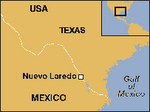The following article was published in the Roswell Daily Record on September 3, 2008.
By Frank Levine
The horrific violence exploding less than three-hours away from Roswell in Mexico is on the verge of jumping the border and spreading north - threatening not only innocent civilians, but area law enforcement officers as well, according to studies by the National Drug Intelligence Center and a prominent private sector intelligence source.
In recent weeks, dozens of Mexican law enforcement officers have been killed and tortured by alleged members of drug cartels fighting for control of drug transit points into the United States - especially in the Ciudad Juarez sector, El Paso's proverbial "sister city."
Two weeks ago, there were 40 homicides in Juarez, raising to more than 900 homicides in the city since the beginning of the year, according to Mexican government officials and news reports.
Already there are signs that the drug war in Mexico is spilling across the border. Killings and kidnappings, especially along Texas' I-35 corridor, from Laredo to Dallas, and in the Phoenix area, have been linked to cartels in recent years, but the latest threats appear to represent more than isolated incidents and are focused near the Texas-New Mexico border areas in what the NDIC describes as a "High Intensity Drug Transportation Area."
Last week, The Associated Press reported that the El Paso Police Department had received credible information that Mexican drug cartels have authorized their members to conduct targeted killings in the United States. In response, Customs and Border Protection agents were put on high alert and security has been stepped up all along the border, according to Stratfor.com, a prominent online publisher of geopolitical intelligence, based in Austin, Texas.
Wednesday, however, an El Paso police spokesman said that the original threat story had been blown out of proportion, and was based on an unverified intelligence shared among law enforcement agencies "that fell into the wrong hands," and that people in New Mexico and the surrounding area should not be overly concerned.
His view, however, is becoming more and more isolated.
In June, the AP reported that 15 individuals, including U.S. law enforcement officials had been targeted in West Texas and New Mexico.
"Attacks ordered by Mexican drug cartels are nothing new," according to an Aug. 26 Stratfor analysis. "A team of cartel hit men carried out a tactical assault conducted on a home in the Phoenix metro area June 23, gunning down a Jamaican with ties to the drug trade. On Dec. 14, 2007, four men carried out a home invasion in Tucson, Ariz., when they entered a Border Patrol agent's home, firing at him in what appeared to be an attempted assassination. The Border Patrol agent returned fire, however, causing the four men to flee. These particular incidents did not receive - or perhaps merit - much response from the media or federal government. By contrast, the increased publicity following the El Paso warning changes the dynamic."
In an April 11 situation report, the NDIC stated that Mexican "drug trafficking organizations," or DTOs, "operate in at least 195 cities throughout the United States and in an additional 129 cities." law enforcement officials reported the presence of Mexican DTOs with affiliations to at least one of the four principal Mexican drug cartels that supply illicit drugs to U.S. markets - Federation, Gulf Coast, Juarez and Tijuana cartels.
Much of the current violence in northern Mexico, especially in the Juarez area, has been attributed to a bloody turf war between the Sinaloa and Juarez cartels.
The threat to U.S. law enforcement is significant, when considering that elements within the cartels have heavily armed paramilitary units consisting of former Mexican army soldiers, some of whom were trained in special operations - often by their U.S. Army counterparts at Ft. Benning, Ga.
According to the NDIC report, New Mexico has four cities clearly identified with Mexican drug cartels. They include Albuquerque and Columbus, Deming and Las Cruces; all but Albuquerque identified with the Federation. The report did not identify Albuquerque with a specific cartel, possibly because more than one operates in the area.
Although Roswell was not mentioned in the report, Highway 285 traversing southeastern New Mexico, was noted in a separate NDIC report as a part of "high intensity drug trafficking network."
According to last week's Stratfor analysis, money is driving the violence northward into the U.S., especially in the so-called "front-line" border states, including New Mexico.
" ... There are economic incentives for the cartels to extend their operations into the United States. With those incentives comes intercartel competition," the Stratfor analysis said, "and with that competition comes pressure on U.S. local, state and, ultimately, government and police functions. Were that to happen, the global implications obviously would be stunning ..."
In its separate "2008 Drug Market Analysis," the NDIC clearly stated, "This (cartel) violence could spill into the HIDTA region, since DTOs may more readily confront law enforcement officers in the United States who seek to disrupt these DTOs' smuggling operations. Violence has extended into the HIDTA region in the past when traffickers felt pressure from U.S. law enforcement. For example, a number of armed encounters between Mexican traffickers and U.S. law enforcement personnel occurred on the U.S. side of the border in 2006.
The report continued: "On two separate occasions heavily armed units of traffickers appeared on the banks of the Rio Grande River east of El Paso during smuggling attempts, preventing law enforcement officers from pursuing couriers, who fled across the border into Mexico.
"Although these confrontations did not escalate into violent shoot-outs, U.S. law enforcement officers were prevented from apprehending drug couriers because of the manpower and cache of weapons possessed by Mexican traffickers. It is quite likely that this type of violence will escalate because DTOs are increasingly contending with drug enforcement operations in Mexico as well as the United States."
Friday, December 05, 2008
Drug violence may jump border
Posted by
Frank Levine
at
03:30
![]()
Labels: border, drugs, juarez, law enforcement
Subscribe to:
Post Comments (Atom)







No comments:
Post a Comment